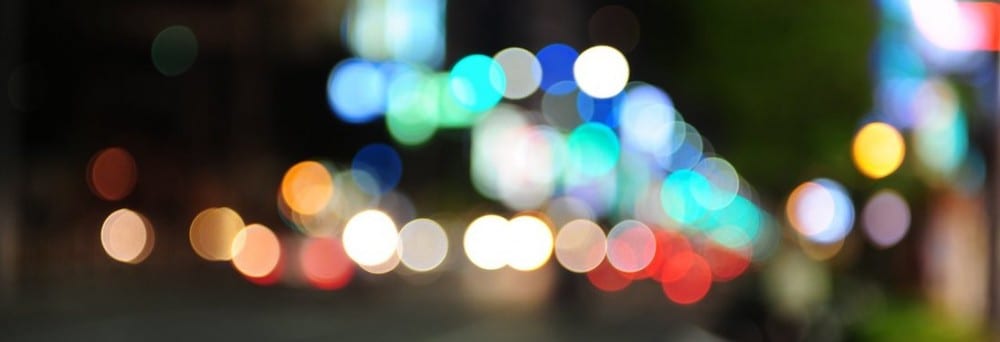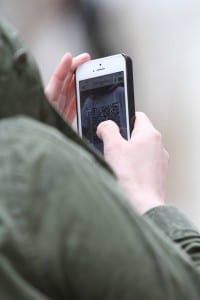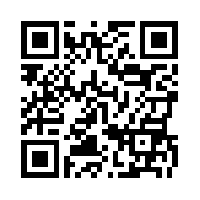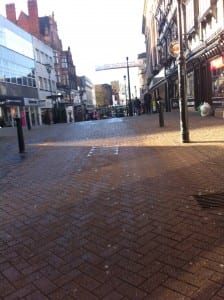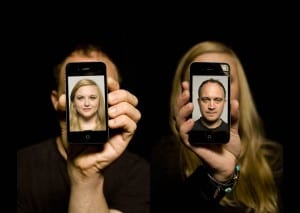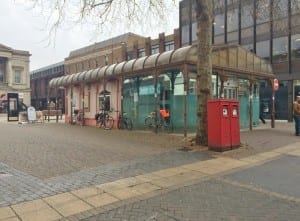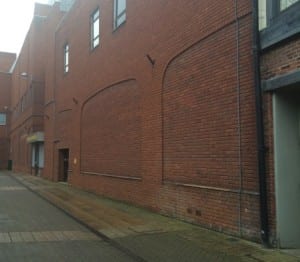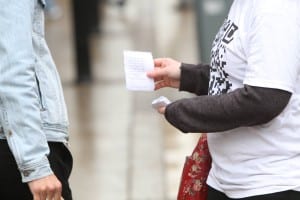Framing Statement
Site Specific Performance is a completely different discipline to anything we have been taught before. We were asked to create a performance that would take us away from the familiar theatre environment and only work in a separate setting provided. For us, that setting was Lincoln High Street. Our group also had an additional briefing, as we were asked to submit our final performances to Lincoln’s Frequency Festival in the hope of being chosen to perform. The theme of this year’s festival is liberation, so we somehow had to include an element of that into our performance as well.
While creating our performance, we looked to many different theorists and works to give us inspiration, including Guy Debord and the Situationists, as well as performances such as I Wish I Was Lonely (Thorpe & Walker, 2015). We discovered pretty early on, however, that it appears nobody has used the media we used in a performance context ever before.
Pervasive Media
“Pervasive Media is basically any experience that uses sensors and/or mobile/wireless networks to bring you content (film, music, images, a game…) that’s sensitive to your situation – which could be where you are, how you feel, or who you are with.” (Pervasive Media Studio, 2015)
An additional element of our performance came in the form of Pervasive Media. Our group immediately picked up on the use of mobile phones within Pervasive Media, as mobile phones have become such a huge part of everyday life, especially within the last five years. We researched the use of mobile phones and their capabilities in a public space, and decided to harness those capabilities to aid in our performance.
Questioning Retail
Our performance, entitled Questioning Retail, took place on 7th May 2015 on Lincoln High-Street. It began at 9am and finished at roughly 2pm. The aim of the performance was to question peoples’ views on consumerism and Pervasive Media within the high street site and offer a disruption, however brief, to give them the opportunity to really take in the environment around them. In order to do this, we handed out QR codes, a vehicle usually used for promotion, with links to articles and websites based around five topics: politics, the environment, human interaction, histories, and the physical process of creating our performance. Our audience expected to receive a fifty percent off voucher or something similar; we flipped those expectations on their heads. To keep our audience from just
throwing our QR codes away, as people are prone to do with other promotional literature, we placed relevant quotes and statistics on the reverse of the QR codes to draw their attention and pique their curiosity.
As well as this, we felt our performance needed an additional level. We therefore placed an additional QR code on a t-shirt with a statement that reworked the popular ‘Keep Calm and Carry On’ posters. My t-shirt, for example scanned to a link of a poster with “Keep Calm and Carry On?” with a simple question mark addition on it. When handing out QR codes, we encouraged our audience to also scan our t-shirts and converse with us about their opinions on what they found, as well as their opinions on the performance as a whole.
Process
Debord describes media as “capital accumulated to the point that it becomes images.” (Debord, 1992, p. 17) From the very beginning, our group was interested in the use of mass media and technology within society, and how that has affected the way that people shop and even interact in public spaces. Social media has become so prominent in our everyday lives that even when people are together, they would rather communicate through Facebook, Twitter, or other forms of social media than talk face to face. We were interested in liberating them from that, or at least harnessing that to use in a innovative, thought-provoking way.
MaKey MaKeys
In one of our first workshops, we played around with MaKey MaKey technology. This simple computer chip and set of crocodile clips can be used for numerous different purposes, including turning bananas into a drum kit (see Video 1 for more). Using tin foil and crocodile clips, and then holding hands, we created a completed human circuit that enabled us to project different images or sounds from a laptop and projector.
(Video 1)
We liked the idea of having people interacting with us on the high street in a way that physically linked human beings with technology; our initial idea was to have people touch pressure points on our bodies wired up to a MaKey MaKey to produce content that could be projected onto a shop front or wall. We soon realised that the sheer number of wires and laptops needed wasn’t viable, however, nor would it be safe when there was a chance someone could trip or be caught in the wires. This, paired with the fact that we couldn’t think of content to project that would send a strong enough message, meant we scrapped the idea.
Pervasive Games
Leading on from our research into Pervasive Media, we also researched Pervasive Games. (Tapper, 2014) In Tapper’s article, she describes a process of “pervasive playing culture” (ibid, p. 145) between players and non-players within a performance, or ‘game’. Non-players, as described by Tapper, are “unaware that the game exists in the first place”, whereas players do, and this creates an “in-between-ness” between performance and reality. (ibid, p. 147) The players know that they are performing, but the non-players do not, and so, to the non-players, what they witness becomes their reality. This creates “an existential dialogue into which players and non-players are propelled.” (ibid, p. 143)
This article made me think about the nature of performance. If the audience were unaware they were watching or even participating in a performance, was it a performance at all? At what point does something stop being a performance and start being a political statement? As a group, this is something that we explored and brought forth into our final piece, as, to passers-by, we just appeared to be flyering. Only those who asked us what we were doing were brought in on the pervasive game, creating the dialogue as described by Tapper.
“Sit With Me for a Moment and Remember”
After our initial idea of using MaKey MaKeys fell flat, we once again turned back to previous work and theories to inspire us into creating something new. Alys and I looked into Carl Lavery’s 25 Instructions for Performing in Cities, and chose to, in true Pervasive Games style, “leave messages of friendliness” (Lavery, 2005, p. 236) around the high street. Our audience didn’t know they were participating in a performance of sorts, just that someone had left a friendly message on a post-it note in highly populated areas. Another of Lavery’s instructions, “build a forest in a city”, (Lavery, ibid) became the basis of our next idea for a performance.
Linking back with our initial proposal of creating a disruption in the high street, we considered a physically aesthetic disruption in the form of a park or beach scene in the middle of the high street, which would have a bench or deckchair of some kind to enable the public to sit with us and create conversation. As well as Lavery, we took inspiration for this from Sit With Me for a Moment and Remember (Pinchbeck, 2012). In his piece, Pinchbeck asked for just five minutes of each individual’s time, and asked them to sit for a moment, forget about their busy day, and think back to something or someone who made them happy/sad etc. (see Audio 1). The aim of our performance, similarly, would be to take passers-by away from their phones and the idea of consumerism for a moment, both physically and mentally, and offer a respite in the form of a chat. We wanted to create a contrast between the grey, cold high street by laying down turf and potted plants/trees, creating a bubble of tranquillity in an otherwise fast, busy, but somehow lonely space.
(Audio 1)
We decided to move forwards with this idea, going so far as to contact Lincoln Big about hiring the space. It only then occurred to us that the performance wouldn’t be cost effective. With only a £50 budget for our group, and grossly miscalculating the cost of the amount turf and potted plants/trees we would need to make the performance effective, we eventually decided that we needed an idea that was simpler. We used elements of this in our final performance, however, in the fact that we eventually returned to the idea of having a conversation with the public as a disruption.
Quick Response Codes
“QR codes were first created back in 1994. A Toyota subsidiary named Denso Wave developed the code in order to help in the manufacturing process; they aided in tracking vehicles and parts. It was designed to allow for fast decoding
speeds, hence the name Quick Response code.” (Michelle White, 2013)
One of our first workshops had involved us researching QR codes and their possible uses in a performance context. As a class, we were asked to create a scavenger hunt of sorts using QR codes. Our group placed riddles into the QR codes, the answers to which would take the participants to the next QR code until they reached a picture of a pot of gold in a QR code at the end. With our previous problems having been cost efficiency and safety issues, and with QR codes being free to produce with only the cost of ink and paper to think about, our group decided to explore this idea more.
It became apparent very early on that we were tapping into technology that had previously not been used for performance purposes, or at least not to the extent that we were planning. In trying to research past performances, therefore, we came up with startlingly little. This gave us the unique opportunity of creating a completely original piece of work. We turned to the actual space we would be using as a source of inspiration.
Claire Blundell Jones said in her article Tumbleweed: “In the current arena where vehicles dominate, meandering is becoming increasingly unfamiliar; regarded as aimless and wasting time, it is perceived as a lower-social-status activity. ‘Time is money’, and one is encouraged to be constantly in flux, going from one interior to another, from home to the workplace to the gym.” (Jones, 2010, p. 87) People are so busy with their day to day lives that they hardly ever stop to actually take the environment around them in, never mind think about it. We wanted to change that.
We wanted to create a new perception of the high street space – something personal. Pearson described cities as “history [accumulating]. Many live on their rubbish, their debris endlessly accreting beneath the feet […] The remains of the past are all around us.” (Pearson, 2010, p. 97-98) Drawing on this, we explored the idea of creating a dialogue that could elicit a personal link to the high street with each participator, potentially through memory.
Individually, we wanted to give the audience a memory of ours that somehow tied to the high street so that they would then go away and think about a memory of their own. My memory involved books; I was going to position myself outside Waterstones and, in an audio or video track placed in a QR code on my chest, I would tell a story about my favourite book as a child. We soon realised, however, that, while Pearson describes history as an important part of Site Specific performance, the history of the site is usually explored instead of the history of the performer. It became apparent that we could take this performance anywhere and still make it work, which defeated the purpose of it being Site Specific. With this in mind, we returned to the drawing board.
“I Wish I Was Lonely”
A performance of I Wish I Was Lonely (Thorpe & Walker, 2015) renewed our interest in the technological consequences of today’s society. They explained in their performance that we are never really alone even when we are by ourselves, as technology means that we can talk to people online all the time. This could be applied to the high street; people walk past each other every day with their eyes on their phones, quickly moving from shop to shop, and never really see each other. A sense of human physical human interaction is lost.
With this performance fresh in our minds, we began researching Situationism and the work of Debord. Situationists “analyse capitalism in its current consumerist form” (libcom.org, 2006), which coincided with our earlier aims to question consumerism in the retail space. Debord uses the idea of mass media as a spectacle to explain how society has become trapped:
“The spectacle presents itself simultaneously as society itself, as part of society, and as a means of unification. As a part of society, it is the focal point of all vision and all consciousness. But due to the very fact that this sector is separate, it is in reality the domain of delusion and false consciousness: the unification it achieves is nothing but an official language of universal separation.” (Debord, 1992, p. 7)
With the work of Debord and the Situationists in mind, we came to realise that our performance could meld the idea of consumerism and the overuse of technology together, with capitalism being the platform of today’s society’s communication, with technology as the glue that holds it all together.
Culminating the ideas we had had before, we turned to the idea of an instillation rather than a traditional performance as a way of presenting our piece. We brainstormed what most affected the high street and decided on politics, environment, history, and human interaction, as well as the name Questioning Retail for our piece. This is a clever reworking of the original QR meaning. People would be expecting to scan a QR code and receive a voucher code or something similar, so we wanted to flip that assumption on its head. Instead, we were going to research our four topics (with performance process as a fifth category) and put links to websites, articles, and scholarly readings in them, creating hundreds of thought provoking QR codes. We then planned to paste the QR codes up on a shop front or wall for people to see.
Our initial choice of site was a shared doughnut shop and health centre in the centre of the high street. We thought covering the entire outside of the building would create a spectacle large enough that it would have an impact and create dialogue between us and passers-by. We gained permission from the doughnut shop, but unfortunately Lincoln council wouldn’t allow us permission to use the health centre half of the building.
Instead, we moved to a separate, less obtrusive site in a side wall of Marks & Spencer. We wrote for permission, but were sadly not granted it here either. A little disheartened, we had to rethink our performance again.
Despite the setbacks, our research had enabled us to “[stop] seeing the street as a series of snapshots but as an endless movie” (Crab Man and Signpost, 2011, 16), and so we set about thinking up an alternative to the instillation. The final idea came in the form of handing out hundreds of QR codes instead of pasting them somewhere. Here, we would take on the pseudo-role of promoters, luring our audience into believing they will be getting some kind of discount code, whereas instead they would be taken to a website, picture or video that questioned not only the high street itself, but their views of it. With our performance set to coincide with the general election, the idea of flyering took on a whole new level.
We were advised to add an additional level to our performance, so we once again returned to the idea of disrupting the flow of people by having a conversation. We created a series of conversation starters that we put into QR codes on the t-shirts that we wore, and encouraged people to scan us and converse about what they found.
These conversation starters followed a template of the ‘Keep Calm and Carry On’ posters popular during the Second World War. With our performance set to coincide with the general election, the idea of using and reworking these posters took on a whole new level.
We also created a separate blog and Twitter account that archived all our QR codes, and put a link to the blog on the bottom of each QR code we printed, should any participants want to find out more: http://questioningretail.blogs.lincoln.ac.uk/
Evaluation
Though we had many setbacks along the way, our final performance proved a success. The bad weather meant we had to cut the performance a little short, as our material was getting wet, but we managed at least five hours on the high street, and successfully gave away all of our QR codes. We also conversed with a wide range of people throughout the day, though for many it was just a few choice words about flyering and/or working for the council, as they thought we were trying to get last minute votes for certain political parties. There were even a few people who believed we were Jehovah’s Witnesses.
Though we don’t have an exact count on the number of people who participated in our performance, we had roughly 1200 codes at the beginning of the day, and they were all gone by the time we had finished. Overall, I think this was very successful.
If we were to move forwards with this piece, I would like to put a stronger emphasis on conversing with the public. We found many people simply weren’t prepared to stop for a moment and talk to us, even if they had a QR code reader on their phones. Additionally, we found that the vast majority of the public didn’t have QR code readers downloaded onto their phones, so they couldn’t participate as thoroughly on the day as some may have wanted to. Instead, some people took the QR codes home to give to friends/relatives who had a reader. In this sense, the disruption still happened in the high street, but the audience didn’t receive anything they could use in exchange for that disruption.
Overall, I feel like our aims were met. We created a disruption in the high street and successfully made people re-evaluate their perceptions of the site, pervasive media, and also consumerism as a whole. In getting them to question these things, we were able to liberate them from them, also.
Word Count: 3103
Bibliography
Blundell Jones, C. (2010) Walking, the Western and the Tumbleweed. Visual Studies. 25 (1) 87-88.
Crab man and Signpost. (2011) A Sardine Street Box of Tricks. Exeter: Blurb. 30-32.
Debord, G. (1992) Society of the Spectacle. 4th edition. London: Rebel Press.
Jay Silver (2012) MaKey MaKey – An Invention Kit for Everyone. [online video] Available from https://www.youtube.com/watch?v=rfQqh7iCcOU [Accessed 14 May 2015]
Lavery, C. (2005) Teaching Performance Studies: 25 instructions for performance in cities. Studies in Theatre and Performance. 25 (3) 229-236.
libcom.org (2006) Situationists – an introduction [online] Available from: https://libcom.org/thought/situationists-an-introduction. [Accessed on 14 May 2015]
Pearson, M. (2010) Site Specific Performance. London: Palgrave Macmillan.
Pervasive Media Studio (2014) What is Pervasive Media? [online] Bristol: Watershed. Available from http://www.pmstudio.co.uk/pmstudio/what-pervasive-media [Accessed 14 May 2015]
Pinchbeck, M. (2012) Sit With Me for a Moment and Remember. [Performance] Michael Pinchbeck (dir.) Derby, Leicester, Manchester, Nottingham and Sheffield.
Tapper, J. (2014) Pervasive Games: Representations of Existential In-Between-Ness.Themes in Theatre, 8, 143-161.
Thorpe, C, Walker, H. (2015) I Wish I Was Lonely. [performance] Chris Thorpe, Hannah Jane Walker (dir) Lincoln: Lincoln Performing Arts Centre, 11 February.
White, M. (2013) What Are QR Codes? [online] New York. Available from http://www.mobile-qr-codes.org/qr-codes.html [Accessed 14 May 2015]
